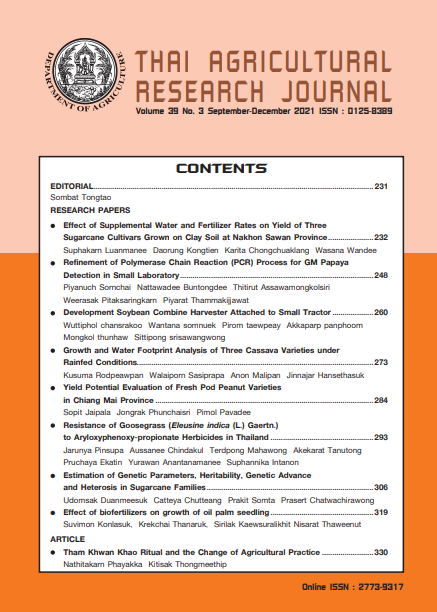Refinement of Polymerase Chain Reaction (PCR) Process for GM Papaya Detection in Small Laboratory
DOI:
https://doi.org/10.14456/thaidoa-agres.2021.20Keywords:
GM papaya, PCR technique, Screening methodAbstract
The ban of Genetically Modified crops importation by many countries, had papaya exporters inThailandscreeningforgenetically modified(GM)papayathroughout theproduction chain i.e., seedling selection, raw material purchasing, and before product exporting to prevent theproduct from beingrejectedat thereceivingend. Nowadays, Real-time PCR technique is popular for the GMO screening and recognized as an international standard method but is high cost to run and high investment for equipment. The aim of this study was to refine the PCR technique that was a basic technique for GM papaya detection in small laboratories. The internal factors (annealing temperature, primer set, DNA concentration and DNA extraction methods) and external factors (PCR machine brand, PCR programs and PCR cycles) for GM screening: the CaMV35S promoter, Nos terminator, neomycin phosphotransferase (nptII), and papain gene by PCR technique were improved. The studies revealed that GM screening by PCR technique have to consist of the following factors:1) The optimum annealing temperature was 58๐ C. 2) The primer final concentration was 0.2 uM and 3) the optimum initial DNA content was 50 nanograms per reaction. Improper DNA extraction methods that did not remove all inhibitorsaffect the PCR reactionyield. Inaddition, reducingtheinitialdenaturationandextension steps by 5 min each and reducing the number of PCR cycles by 10 can help reduce the GM papaya detection processing time by 40 min. and be as effective as the original program that takes approximately 2 hrs.
References
นุชนาถ วารินทร์, ศรีเมฆ ชาวโพงพาง, อัญจนา บุญชด, กนกวรรณ รมยานนท์, ราตรี รอดอารีย์, วิชัย โฆษิตรัตน, สุพัฒน์ อรรถธรรม. 2546. มะละกอพันธุ์ใหม่ต้านทานไวรัสใบด่างวงแหวนมะละกอ.หน้า.539-546. ใน: รายงานการประชุมวิชาการครั้งที่ 14. มหาวิทยาลัยเกษตรศาสตร์. กรุงเทพฯ.
ปิยนุช ศรชัย ธีระ ชูแก้ว ณัฐวดี บุญทองดี ฐิติรัตน์ อัศวมงคลศิริ และขนิษฐา วงศ์วัฒนารัตน์. 2562. การทดสอบความใช้ได้ของการตรวจจำแนกยีน Event specific Mon 810 และ NK603 และยีนอ้างอิงพืชด้วยเทคนิค multiplex real-time PCR. วารสารวิชาการเกษตร. 37 (3): 224-237.
Amersham Biosciences. 1998. PCR Product Analysis: a guide to using semidry flatbed gel electrophoresis. Amersham Biosciences Limited, USA, 52p.
Chris V., S. Agapito-Tenfen, and G. Abou-Sleymane. 2014. Overview of available detection methods, including validated methods in Summary of The activities under the electronic network of laboratories for the detection and identification of Living Modified Organisms (2012-2014).page 8-22. In: Conference of the parties to the convention on biological diversity serving as the meeting of the parties to the Cartagena protocol on Biosafety, 7th meeting Pyeongchang, Republic of Korea, 29 September-3 October 2014.
Debnath, M., Prasad G.B.K.S and Bisen P.S. 2010. Molecular Diagnostics: Promises and Possibilities Dordrech Heidelberg London, Springer, pp 129-152.
Hahn, M., J. Wilhelm and A. Pingoud. 2001. Influence of fluorophor dye labels on the migration behaviour of PCR amplified short tandem repeat during denaturing capillary electrophoresis. Electrophoresis. 22: 2691-2700.
Hwang Bo, K., S.H. Son, J.K. Lee, S.R. Min, S.M. Ko, J.R. Liu, D. Choi and W.J. Jeong. 2010. Rapid and Simple Method for DNA Extraction from Plant and Algal Species Suitable for PCR Amplification Using a Chelating Resin Chelex 100. Plant Biotechnol Rep. 4: 49-52.
Kasajima, I., Y. Ide, N. Ohkama-Ohtsu, H. Hayashi, T. Yoneyama and T. Fujiwara. 2004. A Protocol for Rapid DNA Extraction from Arabidopsis thaliana for PCR Analysis. Plant Mol. Biol. Reporter. 22: 49–52.
Kim, S.R., J. Yang, G. An and K.K. Jena. 2016. A Simple DNA Preparation Method for High Quality Polymerase Chain Reaction in Rice. Plant Breed Biotech. 4(1):99-106.
Mehmet, D., F. Ahmed, JM. Cummins, R. Martin and J. Whelan. 2001. Quantification of the common deletion in human testicular mitochondrial DNA by competitive PCR assay using a chimaeric competitor. Mol Human Rep. 7:301-306.
Peist, R., Honsel, D., Twieling, G., Löffert, D. 2001. PCR inhibitors in plant DNA preparations. QIAGEN News. 3:7–9.
Roger, S.O. and A.J. Bendich. 1985. Extraction of DNA from milligram amounts of fresh herbarium and mummified plant tissues. Plant Mol. Biol. 5: 69-76.
Walsh, P.S., Metzger D.A., and Higuchi, R. (1991). "Chelex 100 as a Medium for Simple Extraction of DNA for PCR-Based Typing from Forensic Material". BioTechniques. 10 (4): 506–513.
Van Pelt-Verkuil, E., Alex V.B. and Hays J.P. 2008. Principles and technical aspects of PCR amplification. Springer Science + Business Media B.V., Springer, 332 p.
Downloads
Published
How to Cite
Issue
Section
License
Copyright (c) 2021 Thai Agricultural Research Journal

This work is licensed under a Creative Commons Attribution-NonCommercial-NoDerivatives 4.0 International License.
Thai Agricultural Research Journal



